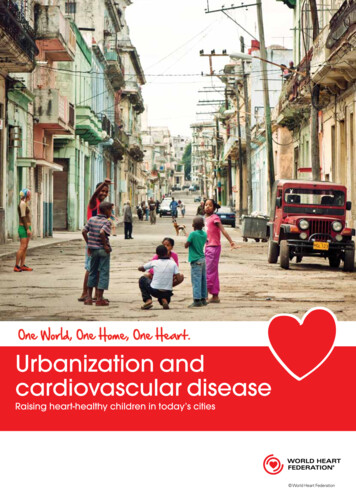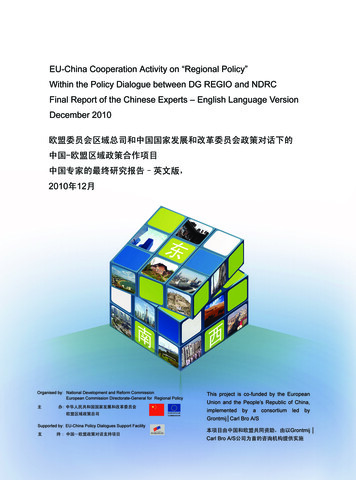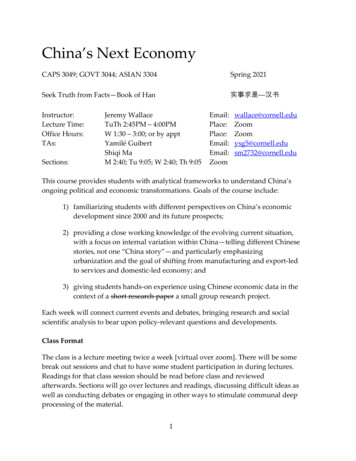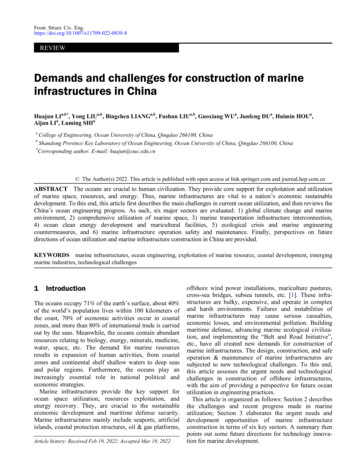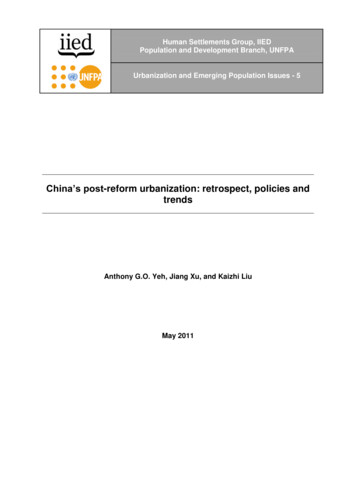
Transcription
Human Settlements Group, IIEDPopulation and Development Branch, UNFPAUrbanization and Emerging Population Issues - 5China’s post-reform urbanization: retrospect, policies andtrendsAnthony G.O. Yeh, Jiang Xu, and Kaizhi LiuMay 2011
Author’s contact:Anthony G.O. Yeh: Centre of Urban Studies and Urban Planning,the University of Hong Kong, Pokfulam Road, Hong Kong SAR.Email: hdxugoy@hkucc.hku.hkJiang Xu: Department of Geography and Resource Management,the Chinese University of Hong Kong, Shatin, Hong Kong SAR.Email: jiangxu@cuhk.edu.hkKaizhi Liu: Centre of Urban Studies and Urban Planning,the University of Hong Kong, Pokfulam Road, Hong Kong SAR.Email: liukz@hku.hk IIED and UNFPA 2011Human Settlements GroupInternational Institute for Environment and Development (IIED)3 Endsleigh StreetLondonWC1H 0DD, UKTel: 44 20 7388 2117 (international); 020 7388 2117 (UK)Fax: 44 20 7388 2826 (international); 020 7388 2826 (UK)Population and Development BranchUnited Nations Population Fund (UNFPA)220 East 42nd StreetNew YorkNY 10017, USATel: 1 212 297 5000Fax: 1 212 297 4930ISBN: 978-1-84369-815-9This paper can be downloaded free of charge from http://www.iied.org/pubs/display.php?o 10593IIED. A printed version of this paper is also available from Earthprint for US 20(www.earthprint.com).Funding for this work was provided by the United Nations Population Fund (UNFPA). Theopinions expressed in this paper are those of the authors and not necessarily those of theIIED or the UNFPA.ii
CONTENTS1 Introduction . 12 Urban growth in China: definitions and measurement . 23 Stages of Chinese urbanization . 43.1 An overview of post-reform urbanization . 43.2 Rural urbanization driven by industrialization (1978 to 1987). 93.3 Urbanization driven by land reform (1988 to 2000) . 123.4 Urbanization driven by the service industry (2001 to present) . 204 Urban planning policies . 224.1 Urban planning regulations. 224.2 Problems of planning coordination . 255 Trends and issues of concern . 285.1 Urban expansion and farmland loss . 285.2 Rural-to-urban migration . 295.3 Social and environmental justice . 306. Concluding remarks . 31References . 33Recent Publications by IIED‟s Human Settlements Group . 40LIST OF TABLES AND FIGURESTable 1: Definitions of urban population and urban area adopted in various Censuses . 3Table 2: Urban population and urbanization level, 1979–2008 . 4Table 3: Number of cities of different population sizes, 1978 and 2007/8 (millions) . 8Table 4: Premier industries in the outline of the reform and development of the Pearl RiverDelta . 22Table 5: Areas of cultivated land under reform in selected coastal areas, 1979–1997(thousand hectares) . 28Figure 1: China‟s urbanization level and the stages of urbanization . 6Figure 2: Urbanization level and urban population, 1979–2008 . 6Figure 3: Urbanization level by province, 2008 . 7Figure 4: Number of cities and urban built-up area, 1981–2008 . 8Figure 5: Number of employees of TVEs, 1980–2000 . 10Figure 6: Number of towns and townships, 1984–2007 . 11Figure 7: The process of rural industrialization . 12Figure 8: Urban land-use tax, 1991–2000 . 14Figure 9: Employment and investment in the real-estate sector, 1989–2008 . 15Figure 10: Urbanization and urban development driven by land reform . 16Figure 11: Cities and zones opened to foreign investment in the 1980s . 16Figure 12: The expansion of urban built-up area, 1981–2008 . 17Figure 13: China‟s mega-city region . 18Figure 14: A model of the emerging urban spatial structure of Guangzhou, China . 19Figure 15: Urban economic structures by employment and GDP, 1995–2005 . 20Figure 16: The growth of the main service sectors, 1978–2008 . 21Figure 17: Types of plans and their coverage . 24Figure 18: Fragmented regional planning and governance in China. 27iii
1 IntroductionThroughout most of its long recorded history, China has been an agrarian society. Forthousands of years, Chinese people lived in the countryside and engaged in agriculture in asocietal context that valued self-sufficiency. Given the minimal need for the exchange ofgoods within this economic structure, cities and towns were either administrative centres ormilitary hubs, and sometimes both, but these functions were insufficient to stimulate thedevelopment of large prosperous cities as in many other countries. The role of cities andtowns as marketplaces never became well established under the firmly entrenched“physiocracy” ideology that encouraged farming and restrained trade and commerce infeudal China. When the century of foreign incursions began with the first Opium War,Chinese cities were viewed as repositories of alien corruption and vice (Kirkby,1985). Thecity lifestyle was depicted as idle and parasitic, within a strongly anti-urban ideology (Salaff,1967; Ma, 1976; Murphey, 1976). Much later, but still reflecting this outlook, Mao promotedseveral anti-urban and anti-migration policies and even sent young people from cities towork on farms in the countryside during the 1960s in order to endure hardship and learnabout hard work.As a result of this heritage, China was still a predominantly rural society as late as the 1970s.Beginning with the economic reforms of the late 1970s, however, the last three decadeshave witnessed an extraordinary turnaround in China‟s perspective on urbanization, as wellas massive urban growth. Given changing policies and varying definitions of what constitutesan urban area, observers have not always agreed on the exact dimensions of recent urbangrowth, but all concur that it has been enormous. Given that the central government iscurrently directing and supporting further urbanization, the recent pace of China‟surbanization will undoubtedly continue. Various projections anticipate China‟s “urban billion”era. According to the latest official United Nations projections, for instance, China‟s urbanpopulation is expected to increase from 636 million to 1037 million between 2010 and 2050(United Nations, DESA, 2010). Similarly, the McKinsey Global Institute (2009) has forecastthe expansion of China‟s urban population to 926 million in 2025, reaching one billion by2030 – an annual growth rate of nearly 20 million. Such growth rates will be consistent withthose of the past three decades. In short, the overall trend towards rapid urban growth isvery clear.This paper provides a broad and updated overview of urban growth in China, itsdeterminants and its consequences. It attempts to quantify important trends in the Chineseprocess of urbanization and to link these to evolving policy stances, especially economicreform. The paper also describes how urban planning has evolved in unique directions overtime in order to accompany policy changes and how, as urbanization accelerates and theurban economy is restructuring, new challenges have emerged. In sum, the three themes ofthis paper on China‟s urbanization since economic reform are retrospect, policies and trends.The next section (Section 2) discusses the meaning of “urban population” and the level ofurbanization. In China this is a continuing challenge (Ma, 1983; Chan and Xu, 1985; Ma andCui, 1987; Chan and Hu, 2003; Zhou and Ma, 2003), and different measurement techniqueshave led to innacuracies and discrepancies in estimating the urban population (Zhou and Ma,2003). Section 2 thus attempts to clarify the basic concepts of “urban” and “urbanpopulation” in China, and on this basis to establish the basic parameters of its recenturbanization processes.Section 3 traces China‟s urban transformation since economic reform and interprets itsystematically. The past three decades of urban development indicate that the state has hada tremendous influence on urban and regional development, including through Five-YearPlans and other policies and guidelines. This core section of the paper thus focuses on the1
mechanisms underlying China‟s urbanization by examining the stages of urban developmentsince the 1978 economic reform, and looks at the changing landscape of cities and regionswithin the respective stages. Section 4 highlights the policies that affect China‟s recenturbanization and urban development, giving special attention to the role of urban planning.Section 5 discusses issues arising from post-reform urbanization, including the effects onfarmland, migration, and wider social and environmental concerns.2 Urban growth in China: definitions and measurementEnumerating the urban population is simple in theory: there are only two questions toconsider – how to define an “urban area”, and what proportion of the population within thatarea should be counted as “urban”. Although simple in concept, this is particularlycomplicated in the case of China. The country‟s urban population “enigma” (Orleans andBurnham, 1984) concerns the definition of these two elements, and is further complicated bythe national system of household registration.First, the geographical definition of an urban area relates to the actual spatial coverage ofthe built environment that has certain “urban” characteristics, such as urban infrastructure orresidential blocks. This physical reality of a city often does not coincide with its administrativeboundaries. Therefore, in order to enumerate the urban population accurately, it is commonpractice to adopt a statistical demarcation of urban areas, such as the MetropolitanStatistical Area (MSA) and Standard Metropolitan Statistical Area (SMSA) adopted by theUS Census Bureau. However, before 1999, when the first set of criteria for counting urbanpopulations was established in China, the administrative boundaries of cities and towns wereused for urban population statistics. In addition to the lack of coincidence between actualurban areas and the administratively bounded areas, administrative boundaries of cities andtowns have frequently changed, often due to expansion. For these reasons, there has beenconsiderable inaccuracy in measuring the urban population.The second concern is the proportion of the population within the defined urban areas thatshould be counted as urban population. The normal practice is to count those people whostay for a minimum period, such as six months in the year before the Census. The situationin China is complicated by the application of the household registration or hukou status asthe criterion for enumerating urban population for some Census years.The hukou system was introduced in the early 1950s, originally for population registrationand later also for migration control. But there are actually two classifications of hukou: hukoutype and residential location. Both were adopted as categories for the enumeration of urbanpopulation in China‟s Census in a rather inconsistent manner. Based on the hukou type, thecountry‟s population was divided into two groups: agricultural (nongye) hukou population andnon-agricultural (fei nongye) hukou population. The key differentiation was the source of aperson‟s grain supply, rather than economic occupation (Zhang and Zhao, 1998). Holders ofa non-agricultural hukou received grain and other goods and services allocated by the state.Those holding an agricultural hukou were assumed by the state to practice farming and soreceived no allocated goods or services. In the pre-reform period, the categorization ofhukou type was an effective way of controlling the movement of population into cities. Asmost goods and services were controlled by the state, people could not live in the citieswithout state-provided resources. The other classification of hukou is based on residentiallocation. Individuals register their hukou to an administrative unit (normally their place oforigin) – for example, a Beijing hukou. A hukou in each location can be either agricultural ornon-agricultural.2
Table 1 indicates the many complex changes in the definition of urban area and urbanpopulation that have been adopted in different Censuses. To complicate matters further, theadministrative boundaries have varied as the criteria defining “city” and “town” changed. Ingeneral, the main criteria for establishing a city are the settlement‟s administrative status,economic functions, size of population and the percentage of non-agricultural hukoupopulation. The State Council can amend these criteria to change a settlement‟s status. Forexample, in 1963, strict criteria1 were adopted to restrict the number of localities defined ascities and towns due to concern about the rapid growth of the urban population and thepossible lack of agricultural capacity to sustain it. The criteria for establishing towns andcities were revised in 1984 and 1986 respectively. The latter‟s criteria for town establishmentremain valid now, while those for cities were again revised by the State Council in 1993.2Such changing criteria greatly inflated the statistics on urban population, when theadministrative boundary was used in counting it.Table 1: Definitions of urban population and urban area adopted in various CensusesThe proportion of population counted as urbanTotalpopulationUrban areaAdministrative Census 1953Boundary (I)(1st)Administrative Census 1982Boundary (II) (3rd)AdministrativeBoundary (III)StatisticalCriteria (I)StatisticalCriteria (II)NonagriculturalhukoupopulationCensus 1964(2nd)Urbanresidence(one year)Urbanresidence(half a year)Census 1990(I) (4th)Census 1990(II) (4th)Census 2000(5th)Census 2010(6th) (ongoing)Notes: 1) China has had five Censuses since 1949, conducted in 1953, 1964, 1982, 1990 and 2000; 2)Administrative Boundary (I) refers to the administrative boundaries of the cities and towns;Administrative Boundary (II) refers to the administrative boundaries of the cities and towns excludingthe counties under the jurisdiction of cities; and Administrative Boundary (III) reflects more basic3administrative units in cities and towns, the districts and street offices; 3) Statistical Criteria (I) refersto the document issued in 1999 by the National Bureau of Statistics (NBS), Provisions on StatisticalDivision of the Urban and Rural Area (on Trial); Statistical Criteria (II) refers to the document issued in2008 by NBS, Statistical Division of the Urban and Rural Area; 4) “Urban residence (one year)” refersto people who had been living in the urban area for more than one year by the Census date.With the evolution of the definition from an administrative boundary to a statistical area for anurban area, and from total population to hukou category to urban residence on a half-yearbasis, the statistics on China‟s urban population are becoming increasingly realistic (Chanand Hu, 2003; Zhou and Ma, 2005). Table 2 shows the estimated urban population and levelof urbanization by year in post-reform China, according to official sources.1According to the regulation, a minimum requirement of setting up a town is either a cluster of 3000people having a non-agricultural population of more than 70 per cent, or a cluster of 2500 people witha non-agricultural population of more than 85 per cent. Compared with the previous requirement (aclustered population of 2000 with non-agricultural population over 50 per cent), the new regulationconveyed a signal of anti-urbanism.2For the detailed evolution of town and city establishment criteria, see Zhang and Zhao (1998).3For detailed discussion on the variations of these criteria, see Kirkby (1985), Ma and Cui (1987) andZhou and Ma (2003).3
Table 2: Urban population and urbanization level, nlevel (%)YearUrbanpopulation(million)Urbanizationlevel 33.5128.12008606.6745.7Notes: 1) data before 1982 refer to the non-agricultural population; data from 1982 to 1989 areadjusted based on the 1990 Census; data from 1990 to 2000 are adjusted based on the 2000Census; data from 2001 to 2004, and 2006 to 2008 are adjusted based on the annual population45survey; data from 2005 are adjusted based on 1 per cent sampling in 2005; 2) Census data are for 1November while data in this table use 31 December; for example, according to Census 2000, theurbanization level is 36.1 (1 November 2000) while in this table the urbanization level is 36.2 (31December 2000).Source: China Population and Employment Statistical Yearbook 2009.3 Stages of Chinese urbanization3.1 An overview of post-reform urbanizationThis section offers an overall picture of the country‟s urbanization trajectory in order to setthe stage for a closer examination of three clearly differentiated recent stages in this process.The main point to be retained is that the pace of urbanization has been much faster in thepost-reform period than before 1978. According to the first Census of the People‟s Republicof China (PRC) in 1953, there were only 77.3 million urban residents, accounting for 13.3 percent of the total population (NBS, 1954). The three decades from 1949 to 1978 witnessed anincrease of only 4.6 per cent in the level of urbanization, signifying an average annualincrease of 3.8 million urban people and an overall increase of 114 million in the urbanpopulation. Most of this modest increase in urban population occurred in the first decadeafter 1949, when China embarked on its First Five-Year Plan, involving the launch of4The annual population survey, held for 20 years since 1983, is a major source of annual populationdata at both national and provincial levels.5The Census discussed above is carried out every ten years. Given the rapid change of populationdata, the National Bureau of Statistics holds a “1 per cent” sampling survey between Censuses,usually in the middle year between two Census years.4
industrial and military modernization projects.6 Shortly after this planning period, however,political movements toppled production and construction, slowing down the development ofthe whole country, including the cities.It was not until the economic reform of 1978 that China‟s urbanization started to take off and,since then, the two processes have fed off each other. With the introduction of marketmechanisms in the 1978 reform, growth factors such as labour, land, capital andtechnologies (including vernacular techniques) could be mobilized for increased economicaccumulation. The three decades after 1978 (1979–2008) thus saw an increase of 26.7 percent (from 19.0 to 45.7 per cent). The urban population increased from 185 million to 607million, an average annual increase of 14.1 million, nearly four times the rate of the prereform era. As will be shown below, the last three decades have also seen an increase in thenumber of cities, in average city size, in the number of large cities and in the urban built-uparea.During this period, cities have played a central role in the country‟s social and economicdevelopment. In 2001, urbanization (chengzhenhua in Chinese) was, for the first time,written into the 10th Five-Year Plan (2001–2005) as an explicit development strategy. In2001, cities and towns accounted for half of the national industrial output, 70 per cent ofGDP, and 80 per cent of all national tax revenue. Some 90 per cent of higher education andscientific research resources were located in cities and towns (People‟s Government ofPRC, 2001a).As noted in the Outline of the 10th Five-Year Plan:“.enhancing the level of urbanization and shifting rural population benefits anincrease in peasants‟ income, enlarges the consumer market, optimizes therural/urban economic structure with the advance of productivity in the agriculturalsector and acceleration of industrialization, the time is ripe for the promotion ofurbanization and we should not miss such a chance to implement the strategy ofurbanization.”(People‟s Government of PRC, 2001a, translated by authors)Urbanization was viewed as a stimulus for economic growth and a solution for rural–urbandisparities. The significance of urbanization was reiterated in the 11th Five-Year Plan (2006–2010). The resolution to promote further urbanization was confirmed, with emphasis on ahealthier development trajectory:“.adhere to the coordination of the development of large, medium and small sizecities and towns; enhance the carrying capacity of cities and towns; promoteurbanization actively and steadily to transform the dual rural/urban structure underthe principles of step by step, saving land, intensive development and rationaldistribution.”(People‟s Government of PRC, 2006, translated by authors)According to a model derived from other advanced industrial countries, China‟s urbanizationprocess is now in the accelerating stage7 (Figure 1) (Pannell, 2002). Figure 2 indicates thatthis accelerating trend also applies to both China‟s urbanization level and its urbanpopulation growth.6PRC launched its 1st Five-Year Plan (1953–1957) to advance industrialization and modernizationwith 156 major construction projects under the supervision of the Soviet Union.7Renowned American Geographer, Ray M. Northam examined the urbanization process in Europeanand American cities, and generalized that urbanization goes through three phases: initial, acceleratingand stable. The process enters the accelerating phase when the urbanization level reaches 30 percent. Other advanced industrial countries, including Japan, have followed similar patterns.5
Figure 1: China’s urbanization level and the stages of urbanizationNote: x—x shows China‟s urbanization level in respective years.Source: Pannell, 2002: 1571.Figure 2: Urbanization level and urban population, 1979–2008Source: China Statistical Yearbook 2009.Within these overall national trends, urbanization patterns vary considerably across thecountry, with the eastern region showing the highest level of urbanization, followed by thecentral and western regions. In 2008, 56.2 per cent of the population in the eastern regionwas urban, while the figures for the central and western regions were 43.0 per cent and 38.3per cent respectively. There are also variations between provinces (Figure 3). The four6
independent municipalities of Beijing, Shanghai, Tianjin and Chongqing are all highlyurbanized, especially the first three, which have over 75 per cent urbanization levels.Provinces with over 50 per cent urban population are concentrated mostly in coastal areasand the northeast, such as Heilongjiang, Liaoning, Jilin and Inner Mongolia, which used tohave a heavy-industrial base. There is also a close relationship between urbanization leveland per capita GDP of provinces.8Figure 3: Urbanization level by province, 2008Source: China Statistical Yearbook 2009.Rapid urban population growth has led to an increase in the number of urban settlementsand to the expansion of urban built-up areas. Thus, the number of cities in China grew from193 in 1978 to 655 in 2008: The most marked increase began in the early 1980s andreached a peak in the mid-1990s (Figure 4). The greatest growth took place in small andmedium-sized cities. Such growth is largely due to the urban development strategy thatprevailed throughout the 1980s, intending to control the size of large cities, rationally developthe medium-sized cities and actively develop small cities. Nevertheless, the number of citieswith more than 1 million people grew from 13 to 58 and their population increased from 29.9to 148.3 million – an increase larger than the sum of the other city-size groups‟ increase(Table 3).8The correlation coefficient between urbanization level and per capita GDP for the 31 provinces is0.93 (correlation significant at the 0.01 level).7
Figure 4: Number of cities and urban built-up area, 1981–2008Source: China Urban Construction Statistical Yearbook 2008.Table 3: Number of cities of different population sizes, 1978 and 2007/8 (millions)Number of Populationadditionalincreasecities from from 1978City size197820071978 toto 20082008Number Population Number PopulationNumberPopulationOver 6.1million0.2–0.56018.723274.17155.4millionUnder 462236.2Source: China Urban Development Report 2008.There has also been a trend towards rapid expansion of the urban areas (see Figure 4).From 1981 to 1999, the annual expansion of urban built-up areas was around 800 squarekilometres. Since 1999, the growth rate almost doubled to around 1700 square kilometresper annum. The urban built-up area has grown much faster than the urban population. From1981 to 2008, the annual growth rate of urban population was 4 per cent whereas the8
corresponding figure for urban built-up area was 6 per cent. Altogether, the urban built-uparea grew dramatically from 7438 to 36,295 square kilometres, a fivefold expansion.In summary, the four key characteristics of urbanization in post-reform China are:1. A rapid growth of the urban population, with an increase of 421.7 million people,resulting in an increase of the country‟s urbanization level from 19 per cent to 45.7per cent. This rapid growth is continuing, and anticipated to become even faster.2. Variations in urbanization levels by region, with the wealthier eastern region having ahigher level, followed by the central and western regions. Variations are alsoobserved at the provincial echelon, with richer provinces being more urbanized.3. A rapid growth in the number of urban settlements, with the numbers of small andmedium-sized cities growing faster than those of large and extra-large cities.However, in absolute terms, urban population growth was concentrated in the largestcities.4. A rapid expansion of urban area, resulting in a total urban area in 2008 that was fivetimes that of 1981. Moreover, the expansion of the urban built-up area has beenaccelerating since the beginning of 2000.The following sub-sections discuss the role of government policy in the acceleration of urbangrowth processes in the post-reform period. China‟s post-reform urbanization can be dividedinto three main stages, according to the forces that affected it. These are: rural urbanizationdriven by industrialization (1978–1987); urbanization driven by land reform (1988–2000); andurbanization driven by the service industry (2001–). Each of these three stages of postreform urbanization had different impacts on the pace and form of urban development, andwill now be considered in turn.3.2 Rural urbanization driven by industrialization (1978 to 1987)Before the development of national economic reform policies, 18 farmers in Xiaogang village(in eastern Anhui Province) inadvertently ignited China‟s rural reform. They signed a secretagreement to divide communally owned farmland into individual plots. This ended uptriggering the collapse of the People‟s Commune System (PCS) and the establishment of theHousehold Responsibility System (HRS). The HRS allowed individual households to take fullcharge of production on their allocated land plots. Essentially, households were allowed toretain grain surpluses instead of turning in the entire farm product to the collectives underthe PCS (Yang, 1996). Peasants‟ initiatives galvanized rural productivity and generated ahuge surplus of farm labourers that had been disguised under the PCS. According to anestimate by Taylor and Banister
International Institute for Environment and Development (IIED) 3 Endsleigh Street London WC1H 0DD, UK Tel: 44 20 7388 2117 (international); 020 7388 2117 (UK) Fax: 44 20 7388 2826 (international); 020 7388 2826 (UK) Population and Development Branch United Nations Population Fund (UNFPA) 220 East 42nd Street New York NY 10017, USA Tel: 1 212 297 5000 Fax: 1 212 297 4930 ISBN: 978-1-84369-815 .
